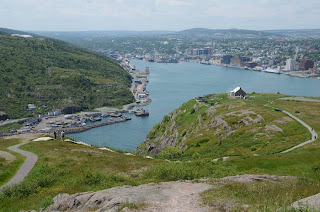After we left Ottawa we spent a couple of days wandering around south west Quebec. The villages mostly have a large church with an ornate bell tower. The village of Hudson is obviously home to really wealthy people - from Montreal? - the homes were huge on huge blocks and with frontages to the St Lawrence river. We did make the mistake of getting too close to Montreal and into the nightmare rat's nest of motorways!
One of the more modest bell towers
On Tuesday we flew to St John's, Newfoundland via Halifax. Front page of the Halifax paper was the renaming of a High School. It has been named Cornwallis after an early British Governor, but the local MicMac Indians objected because he had put a price on MicMac scalps. However someone had written to the paper saying it was not quite that simple. Apparently the local leader of the French (who incidentally was a Jesuit) had previously put a price on the English to encourage the Micmacs to help the French. They played hard in the 18th C.
In St John's we picked up a Ford Fusion with no maps and were dismayed when our GPS did not know St John's existed. We tried all possible spellings and it is a city of about 100,000 people but no luck.. Fortunately it did recognise the post code, but no marks to GPS.
Wednesday we puffin and whale watched. There was quite a swell - made keeping the camera lined up very difficult. Further adventures included a flat tyre. We changed the wheel and went back to Enterprise and changed the car for a Nissan Altima.
Puffins viewed from a heaving boat.
The swell made it hard to keep the humpbacks in the frame.
Ferryland Lighthouse where we had a "Gourmet Picnic"
The idyllic site made it worth the 20 minute uphill walk from the Car Park
Thursday morning we toured the town. Since the collapse of the cod stocks, fishing is no longer so important and I gather the Port is only a shadow of its old self. The town itself has steep narrow streets and rows of wooden terrace houses painted in bright colours. Trivia fact - St John's is much closer to London than Vancouver.
Immaculate 1925 "Roller" at Cape Spear. It has AWB (All wheelbrakes)
Bright sunshine and then the fog rolls in and the eerie sounding foghorn starts to sound.
Blue Fleur de Lis. The emblem of Quebec but it grows wild all through Eastern Canada.
Looking down on St John's Harbour from Signal Hill. This was where Marconi received the first Morse signal from Cornwall in 1901.
Typical view of St John's houses straggling up the steep hills.
There are still a few fishing boats working out of St. John's
In the afternoon we drove to Marystown. The roads are mostly good, but sometimes slow and winding.Friday morning we drove to the Burin Peninsula on the way to Fortune to catch the St Pierre ferry. The coastline of Newfoundland is incredibly indented and the Burin is no exception. It was Captain Cook who charted the coast in the 1760s.
On the Burin Peninsula.
Another view around the Burin Peninsula.
The ferry to St Pierre is not much bigger than a sharkboat. We had about 40 passengers and out on the deck there was quite a bit of spray. As we crossed into French waters the Canadian flag was lowered and the tricolour hoisted.
As the ferry crosses into French waters the Tricolour is hoisted.
The islands of St Pierre, Miquelon and Langlade have a population less than 7000 and the area of St Pierre is 25 sq km. France sends 32 police to keep order. It is a popular posting. There are 10 doctors on St Pierre and every month a specialist comes from France. A weekly cargo boat from Halifax supplies the island.
There is a new smart airport which can land Boeing 737s and most French presidents come to visit. France obviously subsidises their only outpost in North America, a tiny remnant of when they claimed from the St Lawrence to New Orleans.
It is a fascinating and the restaurants serve authentic French food. In the museum there is a guillotine, used once in 1889. The heyday was during prohibition when 300,000 cases of spirits a month passed through St. Pierre. Al Capone was a visitor.
Typical street in St Pierre. Footpaths are pretty optional, note the porches.
This house was built from whisky crates. During prohibition the liquor was transferred from the crates to jute packing for the smuggling run. As a result St Pierre had to find a use for the timber from 300,000 cases a month! They used it for fuel and building.





















It is always a delight to read your posts and see your pictures, Kate!
ReplyDelete